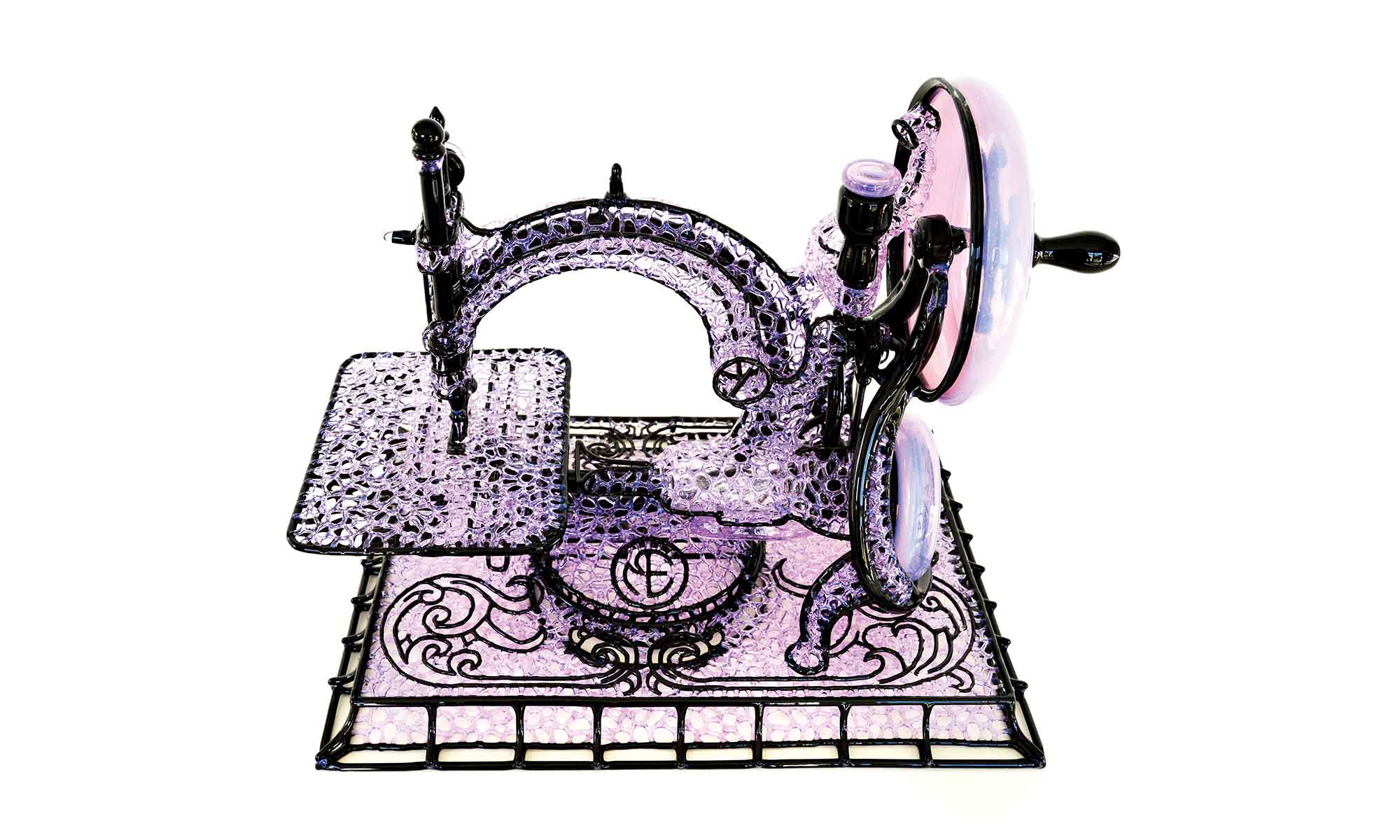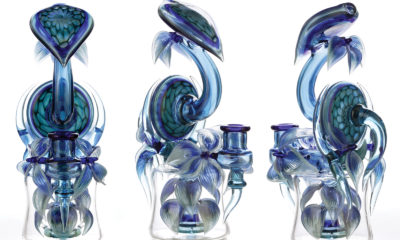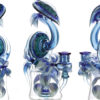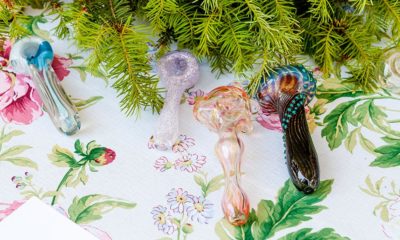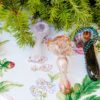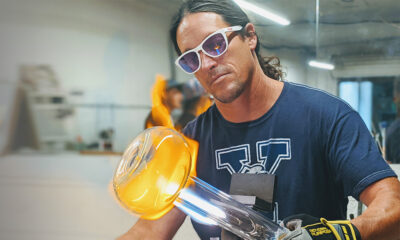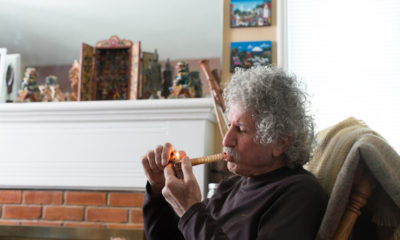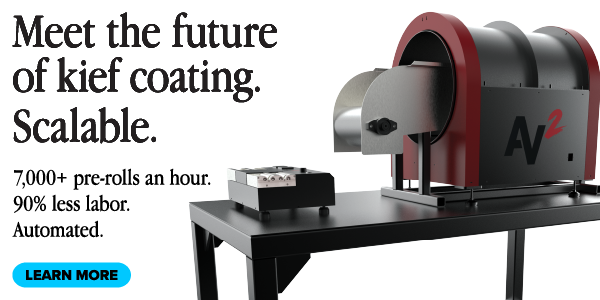The Big Bong Theory
How a clandestine artisanal piece found its way into the Smithsonian. It’s quite a story.
It might not surprise the average epicurean to step inside the Smithsonian American Art Museum and see a glass replica of a 19th-century Willcox & Gibbs sewing machine on display. However, they might be flabbergasted, stupefied and perhaps even a little paranoid upon learning that the piece is a bong. Wait, what?! How’s that even possible?
Considering that the federal government is still exceptionally sensitive about cannabis, how could a device used to chief the reefer be given a spot in the masterpiece mecca of the Land of the Free without the DEA swooping in to drag curators to jail? And if it was put there on the sneak, sort of a thumb in the nose at authority, shouldn’t we be more low-key about it? I mean, we all saw what happened to Tommy Chong several years back…
Relax folks. The bong is on the up-and-up. Dubbed “Raphine,” the distinctive piece is one part art installation, one part marvel of stoner engineering and another part middle finger to the snoots of the art community. It was created by 47-year-old Washington State native Micah Evans, a former art student who went mad for glass during college after a chance encounter with a Seattle hot shop. Calling his obsession with the glass-smithing craft a “disorder,” it’s safe to say that his head has been in a glaze since forging this path 27 years ago. Evans’ story of how this exemplary work of art ended up in the Smithsonian is just as interesting as it is being there.
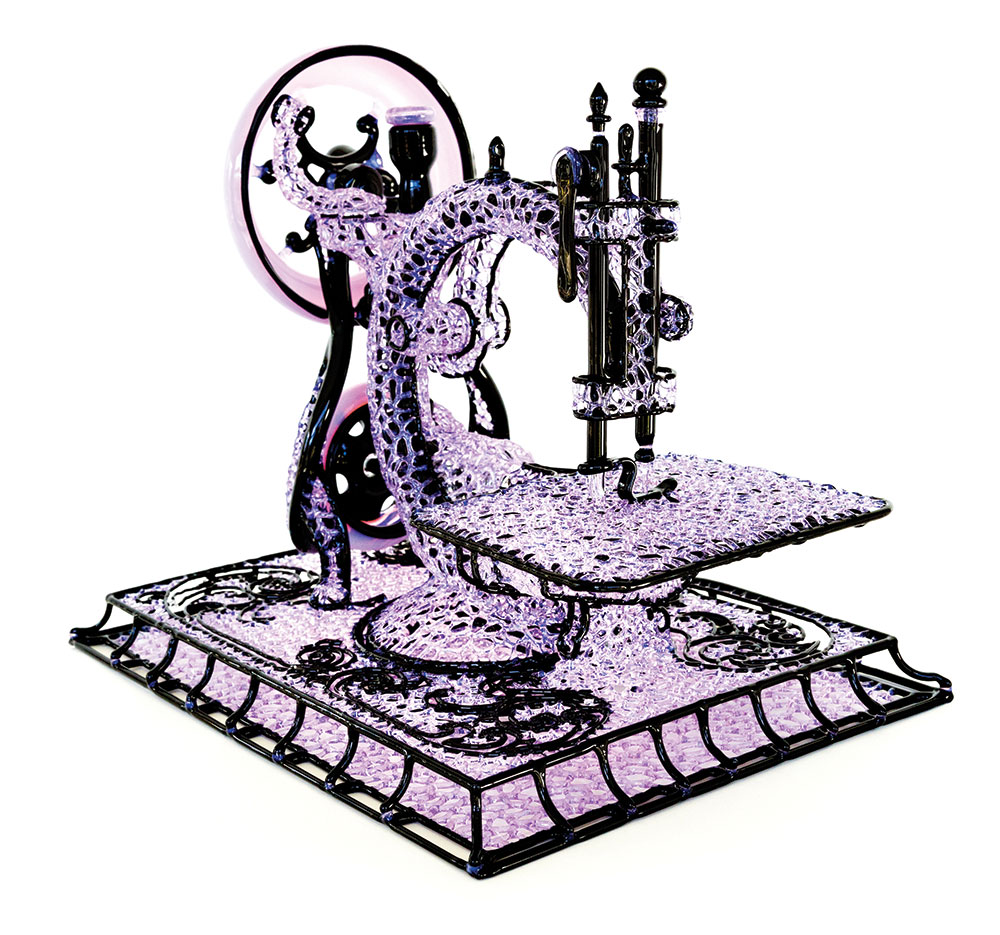
It was during his three-year residency at Penland School of Craft in North Carolina’s Blue Ridge Mountains when Evans learned about a prestigious, highly sought-after pipe show at Art Basel in Miami Beach. These shows are well respected by the international art community, so naturally every meerschaum maven trying to make a name for himself wants a piece on display. Evans was no exception, choosing to submit a recently finished glass 1950s Singer sewing machine as a representation of his work. He modeled the machine after one his mom owned when he was younger. The design was impressive by even the most critical standards—or so it’d seem. Although Evans was admitted into the exhibit, he says it was by the skin of his teeth. The selection jury didn’t consider him a serious pipe maker. “It kind of pissed me off, so I decided I was going to do a sewing machine bong,” Evans says.
He’d show them.
Constructing such an intricate, oddball insertion to this subculture of bong-making was no easy task. The webbing consists of thousands of glass slivers, similar in size to dried spaghetti. Welding these pieces together is an excruciatingly time-consuming undertaking in and of itself. “It’s like knitting,” Evans says.
The black tubing, which acts as the frame, also functions as the smoke corridor. The water chamber is located where the sewing engine is positioned; the bowl pulls out near the hand wheel; and the mouthpiece is in proximity to the needle. It’s certainly a more clandestine fabrication than the traditional bongs found in head shops nationwide. The average person would never even know this “sewing machine” can be used to get you high. And while this charming nod to early American craftsmanship is almost too beautiful to stain with pot resin and dirty bong water—hey, we said almost—it has in fact been toker-tested-and-approved.
“Oh yeah, I’ve used it,” Evans says, citing quality-control purposes. “You have to test it to make sure it works right.”
Later, back at Penland, the sewing machine bong was eventually entered in the school’s annual auction, with the proceeds of all sales going back to the students. Evans admits that it was priced not to sell, going for an amount that he calls his “fuck you price.”
“You can’t put a price on it because it’s priceless,” he says. During the auction, however, Evans noticed an elderly woman admiring the piece. When she inquired as to how much it would cost to take it home, he delivered the bad news. Most art connoisseurs would have scoffed at such a high self-appraisal and likely stormed out. Not this one.
After some consideration, the woman wanted to negotiate. “She asked me if I could do a little better,” he said, adding that her counteroffer was more money than he’d ever made on an art piece. Evans accepted. After all, priceless is only firm when the bills are paid. “She pulled out this folded check and asked who to make it out to,” Evans recalls, admitting that he thought the check would bounce. But after conferring with other artists at the show, Evans learned the woman’s name was Fleur Bresler and she was apparently a reputable, shrewd collector. Needless to say, “the check was good.”
Given that Bresler paid such a generous fee, Evans offered to hand-deliver the sewing machine bong. Although it was a long seven-hour drive up to Maryland, he says it was the least he could do.
During that journey, however, Evans had a bit of a shocking come-to-Jesus moment: He realized he never told Bresler that what she bought was a well-dressed bong. The notion that the reality of her purchase might send her into a Republican state of panic causing her to demand a full refund was of some concern, to say the least. This fear was rooted mostly in the fact that was no cash left to return if, by chance, such a demand was made. “I had already spent a lot of the money,” Evans says. “I was about to head back to Austin, so I had already hired movers.” It was undoubtedly a sticky situation that was going to require delicate hands and precise timing if Evans expected to escape unscathed.
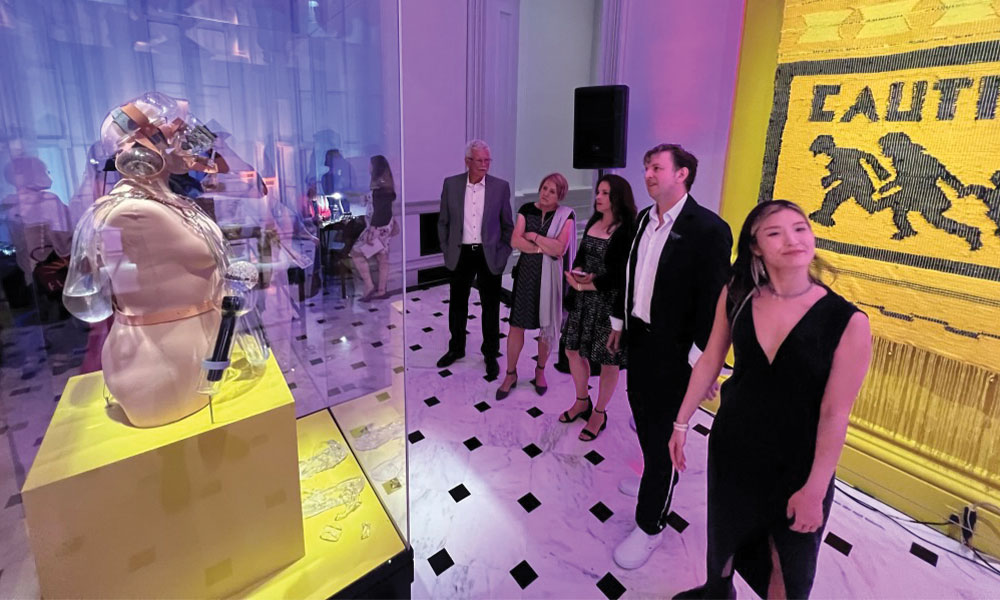
That night, Bresler took Evans out for dinner, where the two got formally acquainted over all things art. Come to find out, not only did she collect inspired works of glass, but she was also a connoisseur of wood and textiles. That’s when Bresler revealed she had a bong in her collection. Evans, feeling like her admission was the appropriate time to come clean, chimed in expeditiously with an unforeseen avowal: “Actually, you have two.”
So much for delicate. Bresler’s reaction was stone-cold silence. Seemingly, it was a moment where she was either pondering how she might have paid more for a water pipe than anyone in American history, or how to have Evans tossed out of the restaurant. The latter, fortunately for him, didn’t happen. Instead, Bresler’s response was even more shocking, solidifying that the two were a perfect match.
“I’ve got a wooden dildo, too,” she said, according to Evans.
Bresler was as cool as they come.
And on top of it, she was a truly distinguished contributor at the Smithsonian. (Is this really happening?) Evans would soon learn that his piece would be part of an exhibit celebrating the 50th anniversary of the museum’s Renwick Gallery, which is dedicated to showcasing American contemporary craft. His bong, along with more than 100 other artists, appeared over the past year in an exhibit called: “This Present Moment: Crafting a Better World.”
Evans’ creation is now immortalized in American history, a creative tribute to the cannabis culture from a bizarre time in prohibition where states are legalizing while the federal government continues a ban. Although the exhibit at the Smithsonian ended in early 2023, the piece will hit the road soon, appearing in museums across the country for art and cannabis fans to enjoy. “Oh man, what an accomplishment,” says Dave Daily, who’s the founder of leading glass brand GRAV and friends and colleagues with Evans. “It’s just an incredible story. Evans is a true artist and designer. This guy has what it takes to do an incredible job.”
Evans signed on at GRAV as a full-time designer in 2016, just as the Penland residency was coming to an end. Fast forward to today and he’s now the Director of Product Design, a position that requires frequent travel to the company’s manufacturing partners in China to oversee the production of its entire line.
This story was originally published in issue 49 of the print edition of Cannabis Now. Read it now on the Cannabis Now iTunes app.



